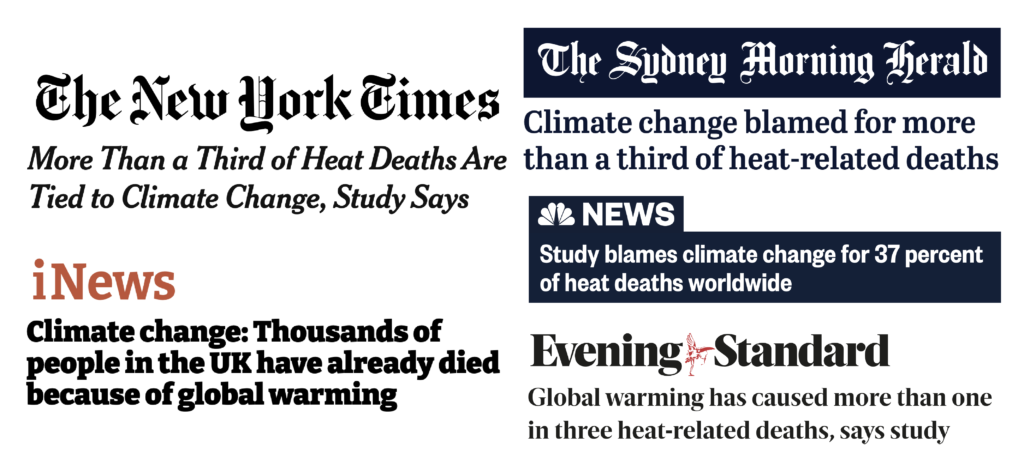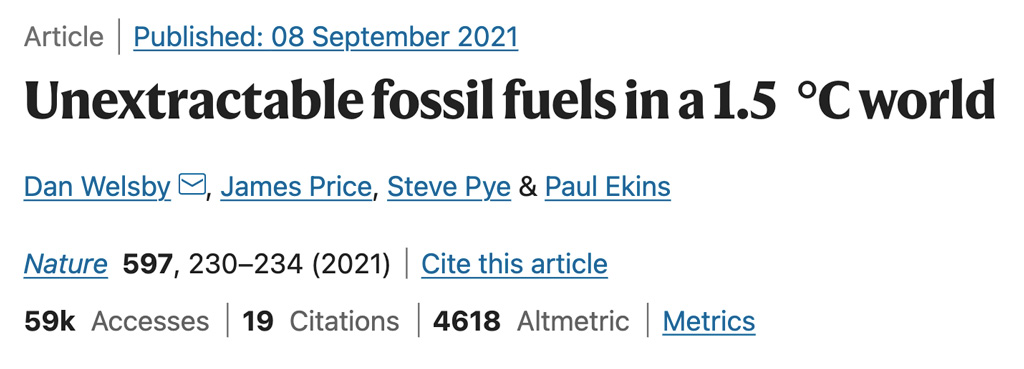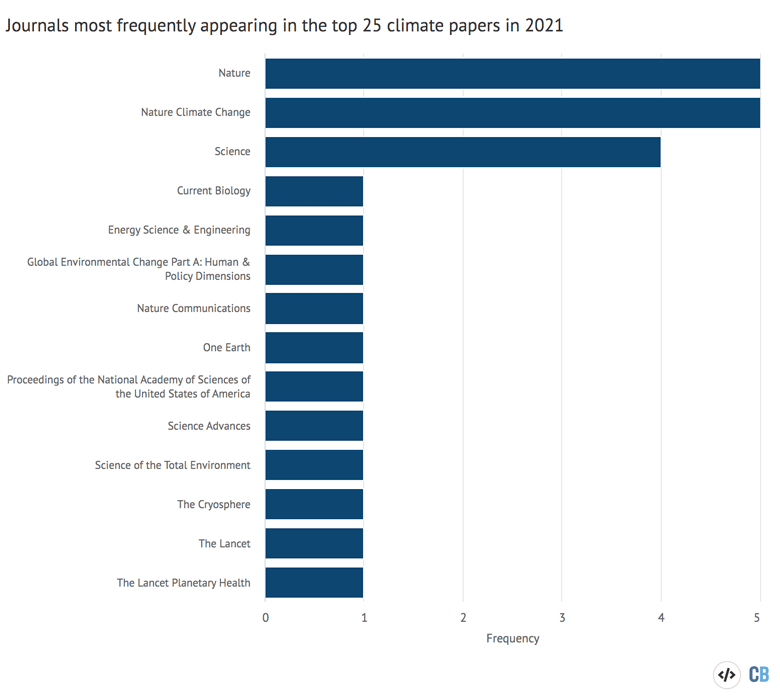Robert McSweeney
19.01.2022 | 8:00am
In a year that was again dominated by Covid, 2021 still managed to squeeze in a summer Olympics with no spectators, a cargo ship getting stuck in the Suez Canal, and various billionaires blasting into space.
Despite the ever-frantic news cycle, climate change nonetheless made headlines – not least because of some record-breaking extreme weather, a new report from the Intergovernmental Panel on Climate Change (IPCC) and the delayed COP26 climate summit in Glasgow.
But also making the news were many of the thousands of peer-reviewed journal papers about climate change that are published every year.
These studies were picked up around the world by news outlets and shared on social media platforms, such as Twitter, Facebook and LinkedIn. Tracking all these “mentions” was Altmetric, an organisation that scores academic papers according to the attention they receive. (Full details of how the Altmetric scoring system works can be found in an earlier article.)
Using Altmetric data for 2021, Carbon Brief has compiled its annual list of the 25 most talked-about climate change-related papers that were published the previous year.
This year’s list includes research on “noisy” oceans, record-shattering weather extremes and the “climate denial” of major oil companies.
The infographic above shows which ones made it into the top 10, while the chart at the end of the article shows which journals feature most frequently in the top 25.
Covid dominance
Research published last year regarding Covid-19 has dominated the media coverage of scientific papers – as it did in 2020.
Studies of the disease – covering everything from its origins to how it spreads and the effectiveness of vaccines, treatments and mask-wearing – account for 99 of the 100 most talked-about papers in 2021. The interloper, in 76th place, is a paper in the Lancet on the effect of the human papillomavirus (HPV) vaccination programme on cervical cancer in England.
The highest-placed climate paper – landing in 144th position overall – is the Nature Climate Change paper, “The burden of heat-related mortality attributable to recent human-induced climate change”.

Using data from 732 locations in 43 countries over 1991-2018, the study estimated that 37% of “warm-season heat-related deaths” can be attributed to human-caused climate change. While this health burden “varied geographically”, the authors found that increased mortality was “evident on every continent” and was “of the order of dozens to hundreds of deaths per year in many locations”.
The study was picked up in 865 online news stories from 617 outlets, including the Guardian, New York Times, Sydney Morning Herald, i newspaper, Times, Bloomberg, Evening Standard, Associated Press and Independent. The paper was also mentioned by 69 blog posts and 1,286 tweets, giving it an overall Altmetric score of 5,715.
This tally is a little lower than the top climate papers in 2020, 2019 and 2018, which scored 6,174, 7,136 and 6,061, respectively.

(For Carbon Brief’s previous Altmetric articles, see the links for 2020, 2019, 2018, 2017, 2016 and 2015.)
AMOC warning
The second highest-scoring climate paper is a “viewpoint” article, published in the journal BioScience, entitled, “World scientists’ warning of a climate emergency 2021”. The paper provides an update on an article published in 2019 in which more than 11,000 scientists declared a climate emergency. The new paper notes that more than 2,800 additional scientists have now signed the original declaration.
However, because the article is a commentary, rather than a research paper, it does not make it onto Carbon Brief’s leaderboard.
(Commentaries are typically commissioned by journal editors, rather than being part of an open submission process. They are also not routinely peer-reviewed. Carbon Brief does include review and perspective articles in the leaderboard, however, as these tend to follow a more traditional editorial process, though this varies by journal. For more on the different types of journal articles, see the guidelines given by Nature and Science as examples.)
Second spot instead goes to “Observation-based early-warning signals for a collapse of the Atlantic Meridional Overturning Circulation”, which was published in Nature Climate Change.

The study warns that the Atlantic Meridional Overturning Circulation (AMOC) – a major system of ocean currents that plays a crucial role in regulating climate – “may have evolved from relatively stable conditions to a point close to a critical transition” over the past century. Using sea surface temperature and salinity data, the researchers show that the previously reported decline in the AMOC over recent decades “may be associated with an almost complete loss of [its] stability”.
The stark findings were reported by 485 news stories from 352 outlets, including the Washington Post, Reuters, Guardian and New York Times. It was also picked up by 32 blog posts and 3,203 tweets, giving it an Altmetric score of 4,839.
(For more on tipping points in the Earth system, see Carbon Brief’s in-depth explainer and accompanying guest post specifically on AMOC.)
Unextractable fuels
In third place is the Nature paper, “Unextractable fossil fuels in a 1.5C world”, which estimated that “nearly 60% of oil and fossil methane gas, and 90% of coal must remain unextracted” by 2050 to keep within a 1.5C carbon budget.

The researchers also find that oil and gas production “must decline globally by 3% each year until 2050”. This implies that “most regions must reach peak production now or during the next decade”, thus “rendering many operational and planned fossil fuel projects unviable”.
Clocking in with an Altmetric score of 4,606, the paper was covered by 510 news articles by outlets including the Hill, Guardian, BBC News, MailOnline, CNN, Associated Press, New Scientist, ABC News and the Australian.
Several of the paper’s authors also penned an article for the Conversation, in which they note that even the “stringent limits” that they outline “may not be enough” on their own to limit warming at 1.5C. This is because their estimates are based on a 50% probability of holding at 1.5C and their model “simply could not be pushed to a greater chance of achieving the 1.5C target because it was already at its limit, given our projections of fossil fuel demand in the near future”.
Toilet-trained cows and ocean soundscapes
Landing in fourth place is a slightly more unusual paper entitled, “Learned control of urinary reflexes in cattle to help reduce greenhouse gas emissions”.
The study is published in the journal Current Biology as a short, peer-reviewed “correspondence” paper. It describes how it is possible to train cattle to “use a latrine for urination” using a “backward chaining, reward-based training procedure”.
The authors suggest that training cattle to urinate and defecate in latrines would improve their welfare while “simultaneously reducing environmental pollution”. In this way, “clever cattle can help in resolving the climate killer conundrum”, the authors say.
Among the paper’s eye-opening findings is that “remarkably, the calves showed a level of performance comparable to that of children and superior to that of very young children”. (For the avoidance of doubt, the paper was published on 13 September and not 1 April.)
The idea of a “MooLoo” generated a flurry of news stories on “potty training cows” – 717 from more than 550 outlets, the second-highest total of the top 25 papers included here. The paper was also mentioned in 18 blogs and 211 tweets, giving it an overall Altmetric score of 4,576.
Rounding off the top 5 is the review paper, “The soundscape of the Anthropocene ocean”, published in the journal Science, which details how “oceans have become substantially noisier since the Industrial Revolution”.
The authors explain that “ocean soundscapes are rapidly changing because of massive declines in the abundance of sound-producing animals, increases in anthropogenic noise, and altered contributions of geophysical sources, such as sea ice and storms, owing to climate change”.
They add that “noise from vessels, active sonar, synthetic sounds (artificial tones and white noise), and acoustic deterrent devices are all found to affect marine animals, as are noise from energy and construction infrastructure and seismic surveys’. There is “clear evidence that noise compromises hearing ability and induces physiological and behavioural changes in marine animals”, the paper concludes.
The research was picked up in 342 stories by more than 220 news outlets, 20 blogs and 1,891 tweets, giving it an Altmetric score of 3,526.
Top 10
Just missing out on the top 5 is the Nature Climate Change paper, “Increasing probability of record-shattering climate extremes”, with an Altmetric score of 3,036.
These “record-shattering” extremes – which break weather records by large margins – will become more likely as the global climate warms, the study warns.
One example was the heatwave that hit western North America in June last year, lead author Dr Erich Fischer explained to Carbon Brief when the study was published:
“We define record-breaking events as events exceeding the previous record by any margin. That may often be just 0.1C warmer than the previous event, which is not relevant in terms of impacts. Where the records become really relevant is if they are shattered like in the case of the Pacific north-west heatwave.”
Imperial College London’s Prof Friederike Otto, who was not involved in the study, told Carbon Brief that it was an “extremely important paper”, which “couldn’t be more timely”. She added:
“After the record-shattering heatwave in the Pacific north-western US and Canada, many people have suggested our climate models are not able to simulate such events. However, this paper shows very nicely that they do. We just haven’t asked the question in quite this way before.
In seventh place, with a score of 3,012, is the Cryosphere review paper of “Earth’s ice imbalance”. The authors combine satellite observations and model data to show that Earth lost “28tn tonnes of ice between 1994 and 2017”.
The Earth has seen considerable ice melt across its surface, the paper says, including “Arctic sea ice (7.6tn tonnes), Antarctic ice shelves (6.5tn tonnes), mountain glaciers (6.1tn tonnes), the Greenland ice sheet (3.8tn tonnes), the Antarctic ice sheet (2.5tn tonnes), and Southern Ocean sea ice (0.9tn tonnes)”.
The authors conclude that “although a small fraction of mountain glacier losses are associated with retreat since the Little Ice Age, there can be little doubt that the vast majority of Earth’s ice loss is a direct consequence of climate warming”.
In eighth, with a score of 2,851, is the 2021 review study from the Lancet Countdown on health and climate change, which is entitled, “Code red for a healthy future”. The Lancet Countdown is an “international collaboration that independently monitors the health consequences of a changing climate” and publishes updates every year.
The latest paper coincided with the COP26 summit, which unfolded “in the context of the Covid-19 pandemic – a global health crisis that has claimed millions of lives, affected livelihoods and communities around the globe, and exposed deep fissures and inequities in the world’s capacity to cope with, and respond to, health emergencies”, the authors say. Yet, they add, “in its response to both crises, the world is faced with an unprecedented opportunity to ensure a healthy future for all”.
In ninth place is the Nature paper, “Amazonia as a carbon source linked to deforestation and climate change”, with an Altmetric score of 2,750.
The study finds that southeastern parts of the Amazon rainforest have switched from a carbon “sink” to a carbon “source” as a result of deforestation and climate change.
The results “cast doubt on the ability of tropical forests to sequester large amounts of fossil-fuel-derived CO2 in the future”, an accompanying Nature News & Views article warns.
Completing the top 10 – with a score of 2,739 – is, “Global, regional, and national burden of mortality associated with non-optimal ambient temperatures from 2000 to 2019: a three-stage modelling study”, published in the Lancet Planetary Health.
The researchers find that, between 2000 and 2019, there were more than 5m deaths per year “associated with non-optimal temperatures” – accounting for around 9% of global deaths. The majority of these were associated with cold temperatures, the authors note. However, while the “cold-related death ratio” declined over the period, the “heat-related excess death ratio increased in most regions”.
Mentioned in 4,703 tweets by almost 4,000 accounts, this paper is the most tweeted-about of any in the top 25.
Best of the rest
The rest of the top 25 sees a mix of climate-related studies, from an analysis of the mitigation potential of “blue hydrogen” (12th place) to a warning of a “widespread” decline in dissolved oxygen in lakes in temperate regions (25th).
In 13th place is the Science paper, “Intergenerational inequities in exposure to climate extremes“. It estimates that “children born in 2020 will experience a two- to seven-fold increase in extreme events, particularly heatwaves, compared with people born in 1960”.
As lead author Prof Wim Thiery from Vrije Universiteit Brussel told Carbon Brief when the paper was published in September, today’s youth will live “an unprecedented life”, facing “conditions which older generations have never experienced”.
In 15th place is “Anthropogenic climate change is worsening North American pollen seasons”, which brought bad news for hayfever sufferers. Published in the Proceedings of the National Academy of Sciences, the study finds “widespread advances and lengthening of pollen seasons (+20 days) and increases in pollen concentrations (+21%) across North America, which are strongly coupled to observed warming”.
As Dr Claudia Traidl-Hoffman of the Technical University of Munich – who was not involved in the study – told Carbon Brief, the research is of “utmost importance” because “climate change is impacting enormously on our health and allergic diseases are in the first line of importance”.
Landing in 16th place is another paper on the impacts of a warming climate. Entitled “Accelerated global glacier mass loss in the early twenty-first century”, the Nature paper shows that glaciers around the world collectively lost around 267bn tonnes of ice every year between 2000 and 2019. This accounted for 21% of observed sea level rise over that period.
The research was described to Carbon Brief as “truly impressive” by NASA’s Dr Alex Gardner – who was not involved in the study. He added that the findings should be used as “further scientifically rigorous evidence” of “the urgent need for rapid and collective action to reduce the dumping of greenhouse gases in our planet’s atmosphere”.
In 17th place is the only Covid-related study on this year’s leaderboard. The paper – entitled “Shifts in global bat diversity suggest a possible role of climate change in the emergence of SARS-CoV-1 and SARS-CoV-2“ – posits that “climate change may have been an important factor” in the outbreaks of Covid-19 by driving increases in “bat species richness” in Yunnan province in southern China, as well as neighbouring regions of Myanmar and Laos.
However, scientists not involved in the study told Carbon Brief that they had concerns about the data the paper uses and the conclusions it draws. Dr Matthew Struebig from the University of Kent, for example, warned that the research contained “too many assumptions for me to conclude that climate change could have increased the likelihood of the pandemic occurring in this way”.
In 19th and 21st place are two unrelated papers concerning the actions of major oil companies in the face of mounting concern about climate change.
The first study, “Rhetoric and frame analysis of ExxonMobil’s climate change communications”, was published in the journal One Earth. The authors argue that ExxonMobil’s public climate change messaging “mimics tobacco industry propaganda” and that its “rhetoric of climate ‘risk’ downplays the reality and seriousness of climate change”.
The second paper, “Early warnings and emerging accountability: Total’s responses to global warming, 1971-2021“ – published in Global Environmental Change – concludes that the company was aware of the “harmful global warming impacts since at least 1971”. It finds that Total “engaged in overt denial of climate science” in the late 1980s and early 1990s.
Looking towards the final placings in the list, in 22nd position, is the Nature Communications paper, “Economic damages from Hurricane Sandy attributable to sea level rise caused by anthropogenic climate change”. It finds that more than $8bn of the damage caused by Hurricane Sandy in 2012 – which triggered “the highest water level in at least 300 years in the New York City metropolitan area” – was due to the increase in sea levels caused by human-caused climate change.
Dr Matt Palmer from the UK Met Office, who was not involved in the study, told Carbon Brief that the study is “pioneering”, adding that it is “an important step forward in improved understanding of the social and economic costs associated with anthropogenic sea level rise”.
All the final scores for the top 25 climate papers of 2020 can be found in this spreadsheet.
Top journals
Across the top 25 papers in Carbon Brief’s leaderboard, there are two journals that feature most frequently – Nature and Nature Climate Change, with five papers each. Nature is perennially high-placed in this analysis, taking first – or joint first – spot in Carbon Brief’s top 25 in 2020, 2019, 2018, 2017 and 2015.
The next highest is Science with four papers represented. Then follows 12 journals with one paper each.

Infographic by Joe Goodman for Carbon Brief.
-
Analysis: The climate papers most featured in the media in 2021
-
Which climate-related journal papers made the biggest media splash in 2021?

